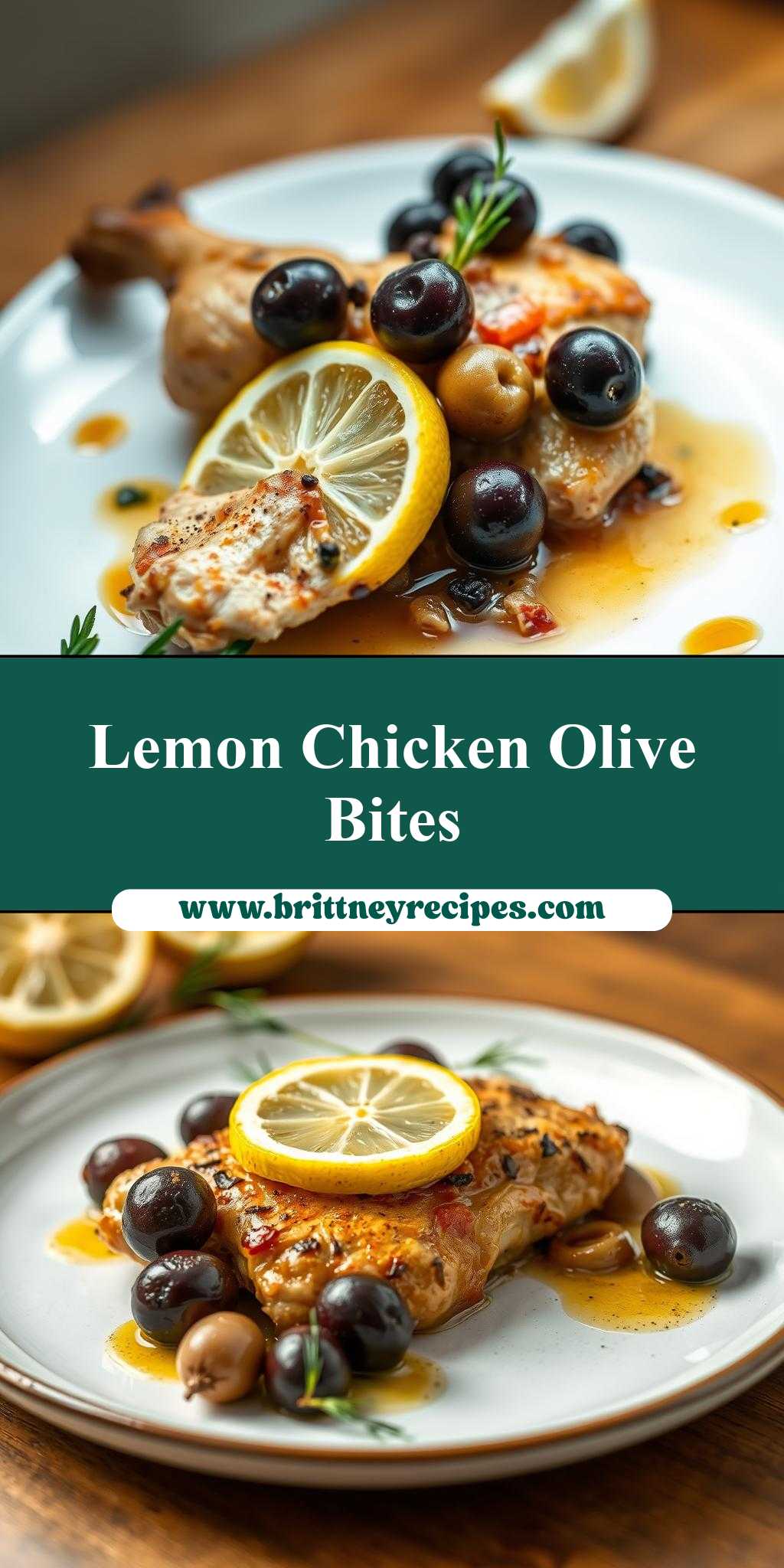What makes a perfect weeknight dinner so satisfying is often the combination of simple flavors, which is why this homemade chicken with lemon and olives is a staple in my kitchen, relying on easy cooking methods and just a few key ingredients like tender chicken and briny olives to make a delicious family favorite, save this idea for a quick and stress-free meal solution.
Chicken with Lemon and Olives
Introduction
Imagine a dish that combines the brightness of lemon, the brininess of olives, and the tender richness of chicken, all in one harmonious and flavorful package. This Chicken with Lemon and Olives recipe is a masterclass in simplicity and depth, using everyday ingredients to create a culinary experience that’s both impressive and comforting. Whether you’re a seasoned chef or a beginner in the kitchen, this recipe is designed to delight your senses and nourish your body, all while being remarkably easy to prepare. The beauty of this dish lies in its accessibility and versatility, making it perfect for weeknight dinners, special occasions, or even as a gift for friends and family.
Why This Works
- Flavor balance and ingredient accessibility: The combination of chicken, lemon, and olives creates a perfect balance of savory, tangy, and slightly sweet flavors, all of which are easily found in most supermarkets.
- Ease of preparation: Despite its sophisticated taste, this recipe requires minimal preparation and cooking time, making it ideal for those with busy schedules.
- Impressive results with minimal effort: The presentation and flavors of this dish are sure to impress, whether you’re serving it at a dinner party or a casual gathering, all achieved with surprisingly little fuss.
Key Ingredients
The core of this recipe revolves around a few key ingredients: chicken breasts, fresh lemons, pitted green olives, garlic, olive oil, salt, and pepper. For the chicken, you can use either boneless, skinless breasts or thighs, depending on your preference for texture and flavor. Fresh lemons are essential for the zest and juice, providing a vibrant and citrusy note to the dish. Green olives add a salty, slightly bitter contrast that complements the chicken beautifully. If you can’t find green olives, you can substitute them with Kalamata or any other brined olive variety. Garlic is used sparingly to add depth without overpowering the other flavors. Olive oil is the best choice for cooking, given its high smoke point and mild flavor that won’t interfere with the dish’s overall taste profile.
Instructions
- Step 1: Begin by prepping your ingredients. Rinse the chicken breasts and pat them dry with paper towels. Slice the lemons, making sure to reserve some for garnish. If your olives are not pitted, remove the pits. Mince the garlic cloves, and measure out the olive oil, salt, and pepper.
- Step 2: In a large skillet, heat the olive oil over medium heat. Add the minced garlic and sauté for about a minute, until fragrant, being careful not to burn it. Then, add the chicken breasts and cook until they are browned on both sides and cooked through, which should take about 5-7 minutes per side, depending on the thickness of the breasts.
- Step 3: Once the chicken is cooked, remove it from the skillet and set it aside to rest. In the same skillet, add the sliced lemons and olives. Squeeze a bit of fresh lemon juice over them and sprinkle with salt and pepper to taste. Let this simmer for a few minutes, allowing the flavors to meld together and the lemons to slightly caramelize.
- Step 4: To serve, slice the rested chicken breasts and place them on a platter or individual plates. Spoon the lemon and olive mixture over the top of the chicken, making sure each piece gets a good amount of the flavorful sauce. Garnish with additional lemon slices and olives if desired.
Handy Tips
- When cooking the chicken, make sure not to overcrowd the skillet. Cook the breasts one at a time if necessary, to ensure they have enough room to cook evenly.
- Don’t overcook the garlic. It can quickly go from perfectly toasted to burnt, which can ruin the flavor of the dish.
- For an extra burst of citrus, serve the dish with a wedge of lemon on the side, allowing each guest to squeeze a bit more juice over their chicken if they prefer.
Heat Control
Maintaining the right heat is crucial for this recipe. When cooking the chicken, you want to ensure it’s cooked through but not overcooked. The ideal internal temperature for cooked chicken is 165°F (74°C). Use a meat thermometer to check for doneness, especially if you’re unsure. For the lemon and olive sauce, a medium heat is perfect for simmering and allowing the flavors to combine without burning or reducing too quickly.
Crunch Factor
The texture of this dish is primarily tender, thanks to the chicken and the softening of the lemons and olives during cooking. However, if you’re looking to add a bit of crunch, consider topping the chicken with some toasted pine nuts or chopped fresh parsley. The contrast between the soft chicken and the crunchy topping can add an interesting dimension to the dish.
Pro Kitchen Tricks
- Marinate the chicken in a mixture of lemon juice, olive oil, and your choice of herbs for a few hours before cooking for an enhanced flavor profile.
- Use a cast-iron skillet for cooking, as it retains heat well and can achieve a beautiful crust on the chicken.
- Let the chicken rest for a few minutes before slicing. This allows the juices to redistribute, making the chicken more tender and juicy.
Storage Tips
- Leftover chicken can be stored in an airtight container in the refrigerator for up to 3 days. Reheat gently in the oven or microwave until warmed through.
- For longer storage, consider freezing the cooked chicken. It will keep for several months. When you’re ready to eat it, thaw overnight in the fridge and reheat as needed.
- When reheating, add a bit of lemon juice or olive oil to keep the chicken moist and flavorful.
Gift Packaging Ideas
If you’re considering gifting this dish, perhaps for a potluck or as a care package, there are several creative ways to package it. For a more rustic look, use a mason jar and layer the chicken, lemons, and olives inside. Secure the lid and add a ribbon around the neck of the jar with a gift tag. Alternatively, place the chicken and sauce in a decorative ceramic dish, cover with plastic wrap or aluminum foil, and tie a ribbon around the dish. Don’t forget to include a few lemon wedges on the side for added freshness and flavor.
Flavor Variations
- Different spices: Consider adding some dried oregano, thyme, or rosemary to the chicken for a herby flavor, or a bit of cumin and paprika for a smoky twist.
- Creative toppings: In addition to pine nuts or parsley, other toppings could include diced onions, capers, or even a dollop of tzatziki sauce for a cool and creamy contrast.
- Ingredient swaps: If you prefer a lighter flavor, you could substitute the chicken with fish or tofu. For a vegetarian version, focus on the lemon and olive sauce served over roasted or grilled vegetables.
Troubleshooting
- Texture problems: If the chicken turns out too dry, it may have been overcooked. Try reducing the cooking time or using a thermometer to ensure it reaches a safe internal temperature without going over.
- Ingredient replacements: If you can’t find green olives, remember that other types of olives can be used as substitutes. For the lemon, while there’s no perfect substitute, you could use a combination of lime and orange juice to achieve a similar brightness and depth of flavor.
- Over/undercooking signs: Always check the chicken’s internal temperature. For the lemon and olive sauce, stir frequently to prevent burning, and adjust the heat as needed to maintain a gentle simmer.
FAQs
- Can I freeze it? Yes, the cooked chicken can be frozen for later use. It’s best to freeze it without the lemon and olive sauce, and then add the sauce when you’re ready to serve.
- Is it gluten-free? Yes, this recipe is naturally gluten-free, making it a great option for those with gluten intolerance or sensitivity.
- Can I double the recipe? Absolutely. Simply multiply all the ingredients by two and cook in batches if necessary to prevent overcrowding the skillet.
Conclusion
This Chicken with Lemon and Olives recipe is a testament to the magic that happens when simple, high-quality ingredients come together in perfect harmony. It’s a dish that’s both nourishing and flavorful, easy to make yet impressive to serve. Whether you’re cooking for yourself or for a crowd, this recipe is sure to become a staple in your kitchen. Feel free to experiment with the ingredients and techniques to make it your own, and don’t hesitate to share your creations and adaptations with friends and family. The joy of cooking lies not just in the eating, but in the sharing and the love that goes into every dish. So go ahead, get creative, and bon appétit!

